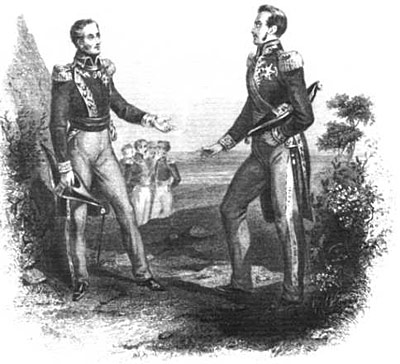
Unit 3: Revolutions and Reaction
Lesson D: The Americas — Land of Revolutionary Opportunity
Lesson Overview
The ideas of the Enlightenment spread to Latin America after the American, French, and Haitian Revolutions. The printing press, colonization, and trade spread ideals around the world. By the 19th century, Central and South America were the next regions to find themselves in the midst of a wave of revolutions, fueled by nationalism and democratic ideas. The revolutions provided independence from colonial rule, but resulted in varying degrees of democracy and rights. Most of the American continents had achieved independence from colonial powers — but not everybody benefited from this new-found freedom.

Simon Bolívar and Jose de San Martín at the Guayaquil Conference, 1822, to Discuss the Future of Peru [1]
Key Questions
- How do trade and migration patterns cause intellectual and cultural transformations?
- What social, political, and economic conditions lead to the overthrow of established ideas?
- How does nationalism impact countries and people?
Student Outcomes
- Analyze how nationalism and revolutionary ideals led to revolutions in Haiti, Mexico, and throughout South America.
- Compare the roles of Creole elites, the Catholic Church, and mestizo, mulatto, and Indian populations in Latin American independence movements.
- Analyze the extent to which revolutions in Latin America accomplished Enlightenment goals.
- Assess the successes and failures of democracy in Latin American countries following independence.
- Trace the development of Canada as an independent nation.
- Analyze cause-and-effect relationships and multiple causation, including the importance of the individual and the influence of ideas. (Historical Thinking Skill)
- Consider and compare multiple perspectives in primary and secondary sources. (Historical Thinking Skill)
- Draw comparisons across eras and regions in order to define enduring issues. (Historical Thinking Skill)
Key Terms
Student Resources
- Latin American Revolutions Graphic Organizer (doc)
- Independence and the Enlightenment Jigsaw Fact Sheets (pdf)
- Independence and Enlightenment Jigsaw Graphic Organizer (doc)
- Early Mexico — The Extent of Democracy (doc)
- Latin American Revolutions Brief Constructed Response (BCR) (doc)
Chart of Activities:
| Activities to Complete | Estimated Time |
|---|---|
| Pre-Assessment | 5 minutes |
| Key Terms | 5 minutes |
| Activator: The World 1700-1900 | 5 minutes |
| Opening: The Roots of Revolutionary Opportunity | 10 minutes |
| Activity 1: Revolutions | 5 minutes |
| Activity 2: Latin American Revolutions | 10 minutes |
| Activity 3: Class System in Latin America | 10 minutes |
| Activity 4: Revolutions of the People | 15 minutes |
| Activity 5: Democracy in Early Mexico | 15 minutes |
| Activity 6: Birth of Latin America | 15 minutes |
| Activity 7: Democracy and Independence in Canada | 20 minutes |
| Review and Assessment | 20 minutes |
| Lesson Summary | 5 minutes |
Lesson Completion Time
The total estimated time to complete this lesson is 140 minutes.
Page Notes:
[1] Source: This image from http://en.wikipedia.org/wiki/File:Encuentro_de_Guayaquil.jpg is in the public domain because its copyright has expired.

